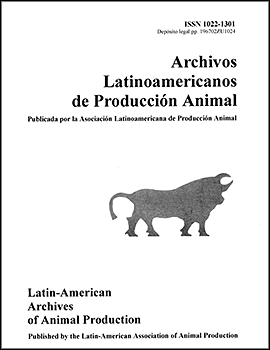
|
Archivos Latinoamericanos de Produccion Animal
Asociacion Latinoamericana de Produccion Animal
ISSN: 1022-1301
EISSN: 1022-1301
Vol. 14, No. 4, 2006, pp. 139-142
|
 Bioline Code: la06024
Bioline Code: la06024
Full paper language: Spanish
Document type: Research Article
Document available free of charge
|
|
|
Archivos Latinoamericanos de Produccion Animal, Vol. 14, No. 4, 2006, pp. 139-142
| es |
Consumo y digestibilidad aparente de raciones basadas en follaje de leguminosas tropicales arbóreas, paja de arroz amonificada y subproductos de maíz suministradas a cabras en confinamiento
G. Nouel Borges; M. Prado Ortega; F. Villasmil; J. Rincón González; M. Espejo Díaz; R. Sánchez Blanco; E. Yépez & E. Suárez
Resumen
Se evaluó el consumo y digestibilidad aparente de raciones que incluyeron follaje de cuatro especies de leguminosas arbóreas, Acacia macrantha (Am), A. tamarindifolia (At), A. glomerosa (Ag) y Leucaena leucocephala (Ll), en mezcla con paja de arroz amonificada (PAA) y harina de subproductos de maíz (HSM), usando ocho cabras criollas en crecimiento, de peso promedio 20.5 kg, alojadas en jaulas metabólicas. El diseño experimental fue en cuadrado latino 8 x8 con un arreglo factorial 4 x 2 de los factores: 1) especie leguminosa y 2) nivel de inclusión del follaje: 18.75 y 37.5% en la materia seca (MS) de la ración. El experimento se dividió en ocho períodos de 14 días cada uno (7 para adaptación y 7 para medición de consumo y colección total de heces fecales). Los ocho tratamientos (raciones) incluyeron 25% de HSM en todo caso y 56.25% de PAA en combinación con 18.75% de follaje de Am, At, Ag y Ll en T1, T3, T5 y T7; ó 37.5% de PAA en combinación con 37% de las cuatro respectivas leguminosas en T2, T4, T6 y T8. Las raciones con Am (T1 + T2) y Ag (T5 y T6) presentaron una tendencia a mayor consumo de MS que T3 + T4, y T7 + T8 (1050 y 980 vs. 836 y 882 g/día, respectivamente, P<0.1011). El mismo patrón fue evidente en digestibilidad de MS (82 y 83 vs. 77 y 80% P<0.008), materia orgánica, fibra insoluble en detergente neutro (80 y 83 vs. 75 y 77%, P<0.013) fibra insoluble en detergente ácido y hemicelulosa (HC). Las raciones con menor nivel de leguminosa en conjunto tendieron a dar mayor consumo de MS (987 vs. 889 g/día) y superaron (P<0.05) a las de mayor nivel de leguminosa en digestibilidad de todas las fracciones químicas citadas menos HC.
Palabras-clave
Acacia glomerosa ,A. macracantha, A. tamarindifolia, consumo, digestibilidad, Leucaena leucocephala, paja de arroz amonificada.
|
| |
| en |
Intake and apparent digestibility of rations based on foliage of tropical leguminous trees, ammoniated rices straw, and corn byproducts for goats in confinement
G. Nouel Borges; M. Prado Ortega; F. Villasmil; J. Rincón González; M. Espejo Díaz; R. Sánchez Blanco; E. Yépez & E. Suárez
Abstract
The consumption and apparent digestibility of rations containing foliage of four arboreal legume species, Acacia macrantha (Am), A. tamarindifolia (At), A. glomerosa (Ag) and Leucaena leucocephala (Ll), in mixture with ammoniated rice straw (ARS) and corn byproducts meal (CBM), were evaluated using eight growing female Creole goats of mean body weights 20.5 kg, housed in metabolic stalls. The experimental design was an 8 x 8 latin square with a 4 x 2 factorial arrangement of the factors: 1) legume species and 2) level of foliage inclusion: 18.75 and 37.5% in the ration dry matter (DM). The experiment was divided into eight periods of 14 days each (7 for adaptation and 7 for measurement of consumption and total feces collection). The eight treatments (rations) included 25% (CBM) in all cases, and 56.25% ARS in combination with 18.75% foliage of Am, At, Ag, and Ll in T1, T3, T5 and T7; or 37.5% ARS in combination with 37.5% of the four respective legumes in T2, T4, T6, and T8. Rations containing AM (T1 + T2) and AG (T3 + T6) showed a tendency toward higher DM intake than T3 + T4 and T7 + T8 (1050 and 980 vs. 836 and 882 g/day), respectively, P<0.1011). Digestibility results followed the same pattern for DM (82 and 83 vs. 77 and 80%, P<0.008), fiber insoluble in acid detergent, and hemicellulose (HC). Rations with the lower level of legume combined, tended to give higher DM intake (987 vs. 889 g/day) and surpassed (P<0.05) those with higher legume level in digestibility of all the chemical fractions mentioned except HC.
|
| |
© Copyright 2006 - ALPA. Arch. Latinoam. Prod. Anim.
Alternative site location: http://www.alpa.org.ve/ojs/index.php
|
|
